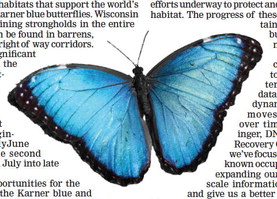Volunteers sought for blue butterfly survey


The Wisconsin Department of Natural Resources (DNR) is seeking volunteers to help collect information about the federally endangered Karner blue butterfly and its habitat to help a...


The Wisconsin Department of Natural Resources (DNR) is seeking volunteers to help collect information about the federally endangered Karner blue butterfly and its habitat to help a...